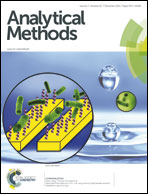Specificity improvement of Invader assay by introducing an artificially mismatched base into the probe†
Abstract
Invader Plus, which combines PCR amplification with invasive cleavage-based signal amplification, is an efficient method for genotyping. However, the non-specific signals in Invader assay are caused by the hybridization of the wild-type probe (target) with the mutated target (probe), leading to a false-positive typing result. To increase the specificity of Invader Plus assays, we proposed to introduce an artificially mismatched base into the region next to the invasive site of the probe. The mismatched base efficiently reduced the thermostability of non-specific invasive structures, therefore the non-specific signals decreased dramatically. We investigated various positions for introducing the mismatched base, and found that the best position is the nucleotide right next to the invasive site. We next genotyped the aldehyde dehydrogenase-2 gene polymorphisms which are related to the individualized medicine of nitroglycerin and the risk of esophageal cancers. The results showed that the non-specific signals from the wild-type probe in the mutated target were significantly reduced by using the mismatched probe. Our improved-Invader Plus method can achieve more accurate genotyping in comparison with the conventional Invader Plus assay, which is more feasible for clinical genotyping tests.


 Please wait while we load your content...
Please wait while we load your content...